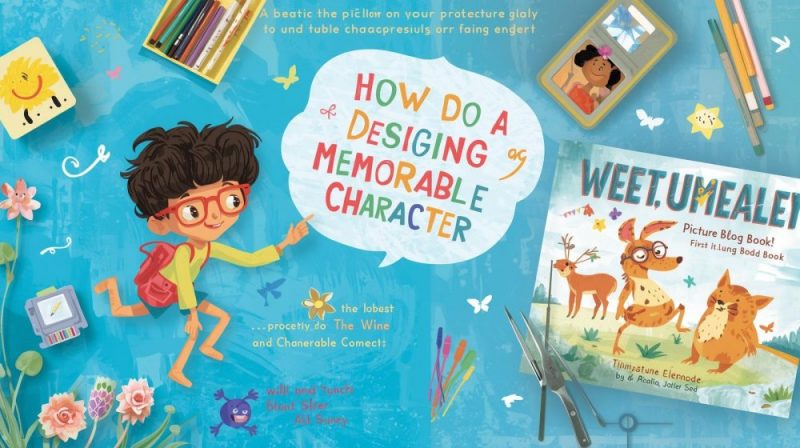“When writing a novel, a writer should create living people, not characters. A character is a caricature.” This quote exemplifies the heart of telling a story: characters must feel alive, not simply be drawn. Think back to the superheroes or fairy tale characters from your childhood. The ones that jumped off the page, who felt real enough to inspire, motivate, or challenge you. Those admirable characters weren’t just characters; they were real people residing in your mind. That is the fun of memorable character design. It is the exact quality that every great picture book attempts to fulfill.
If we talk about building a strong identity for any character in a book, it takes a lot of planning, focus, and study of children’s psychology. A memorable character is more than just visuals. It includes emotions, identity, an inspirational back story, and strong feelings that can influence people.
Whether you are designing a character for a novel, children’s comic, screenplay, or video game, this guide breaks the process into core elements and walks you through how to ace your character design journey, from storytelling to audience psychology and visual references. Keep reading!
Tips To Design a Memorable Character for a Book
We will discuss a few factors that will help you understand how to design a memorable character:
1) Create a Simple Sketch
Start with a rough pencil sketch on paper, from which you’ll draw a bundle of ideas, traits, and types of expression.
A well-structured sketch helps a character be easily recognizable even in the absence of details, as it conveys a certain shape, angle, outline, personality, and role. This is how you can easily see the difference between a character that looks cute and cuddly and a character that looks fierce and dangerous.
Test your design multiple times. You can draw and redraw them, focusing on changes until it forms a desirable upgrade. That is the language of visual storytelling, the foundation of professional Character Design Services.
2) Make Your Character Unique
Whether you are creating a Lion, a Monkey, a little girl, or an action Hero, you should know that they are going to be a wide range of other designs too. Don’t hesitate to push proportions; big heads, long hair, and big eyes can contribute to uniqueness.
A character’s personality becomes more distinct the more you explore their emotional side. And often the best way to accomplish it is to take a little inspiration from other characters who have already inherited the same personality traits when needed.
Another way you can distinguish your character is by improving their poses and expressions. It can include their weight and unusual physique. A character leaning forward aggressively or balancing nervously can help determine whether some gestures or shapes can be pushed further to make them stand out.
3) Color Psychology
If you are familiar with color theory, you know you have several options to choose from when it comes to colors, whether you choose complementary colors, monochromatic colors, triadic colors, or warm or cold parts of the color palette.
Jump to 3-4 colors with each character and add uniqueness to it again, relatively! Empathetic color psychology benefits character design. Dark colors are associated with villains and bold characters, whereas light colors signify heroes and positive, genuine characters.
Knowing how colors can influence emotions is essential to building powerful character color palettes! Here is a quick reference to some common meanings associated with colors:
- Purple – Mystery, royalty, wisdom (e.g., Maleficent, Thanos)
- Red – Energy, passion, aggression (e.g., Deadpool, Mario)
- Blue – Trust, calmness, intelligence (e.g., Sonic, Elsa)
- Green – Growth, nature, envy (e.g., The Hulk, Shrek)
- Yellow – Happiness, warmth, caution (e.g., Pikachu, SpongeBob)
4) Consider Audience
A book illustration aimed at children often features unusual faces and is designed around basic shapes and bright colors. Children are more likely to get inspired by the characters they see as their heroes. It can accordingly reshape their way of seeing the global view.
Commissioned character designs are more restrictive but no less creative. In this situation, it is recommended to break down the character’s core features and personality.
Take an example of Cartoon Network characters. They are really simple and unique, while Disney characters are super detailed. We’re not saying that Cartoon Network artists are lazy or not very creative; it is all about finding the right balance. They need to make sure the character’s personality and traits shine, while also considering the show’s style and the time and resources available.
5) Make the Character Extravagant.
Exaggeration and distortion are artistic techniques that manipulate the form of objects or figures to emphasize certain characteristics or convey emotional impact by altering proportions, shapes, or colors, or by diversely altering features.
Artists can create a heightened sense of expression that goes beyond realistic representation. It can help convey emotions more dramatically than realism by focusing on specific traits or characteristics. This technique is used in certain art forms, enabling artists to effectively communicate ideas and themes.
It takes a solid foundation in observation, original thinking, and the ability to analyze how to effectively imply exaggeration in your character design.
6) Backstory- a Soul of Character design
A strong backstory is what makes a character go from a drawing to a living being. It’s not always about the outfit, the pose, or the colors. It’s about why they are there, what they want, and how their past has affected how they look and their personality.
Think of some of your favorite animated characters or game illustrations. What you love about them is not their superpowers or looks specifically; on a deeper level, it could be a shared emotion, experience, or goal that mirrors your own personal traits. You can relate to their relationships or insecurities; you can catch yourself caring about what happens to them, you know, we root for them or feel their pain, and we celebrate their victories because, in this way, we sometimes see ourselves in them.
A good backstory gives the character depth and feels realistic, such that it also gets artists and illustrators to put meaning into the details. Their hands are scarred, or something is wrong with their eyes. A strong backstory not only creates empathy but also grounds the design with purpose, making it memorable.
Conclusion
Once you are done designing your character and satisfied with all the research, proceed to flesh it out and bring it to a more finalized state. Character design is often about refining the content; this does not necessarily mean adding, but rather improving upon a character accordingly. Creating a character design for a book has never been simple, after all. Character artists are always very careful in crafting a fully fleshed-out personality with distinct visual characteristics out of thin air. The character design process is very deliberate and asks for just as much artistry and storytelling ability. The next time you see a good character design, take some time to hone in on what makes it good and what decisions a character designer made to make it good.



